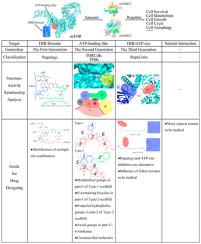European Journal of Medicinal Chemistry ( IF 6.0 ) Pub Date : 2020-09-13 , DOI: 10.1016/j.ejmech.2020.112820 Yifan Chen 1 , Xiaoping Zhou 1

|
Mammalian target of rapamycin (mTOR) is a highly conserved Serine/Threonine (Ser/Thr) protein kinase, which belongs to phosphatidylinositol-3-kinase-related kinase (PIKK) protein family. mTOR exists as two types of protein complex: mTORC1 and mTORC2, which act as central controller regulating processes of cell metabolism, growth, proliferation, survival and autophagy. The mTOR inhibitors block mTOR signaling pathway, producing anti-inflammatory, anti-proliferative, autophagy and apoptosis induction effects, thus mTOR inhibitors are mainly used in cancer therapy. At present, mTOR inhibitors are divided into four categories: Antibiotic allosteric mTOR inhibitors (first generation), ATP-competitive mTOR inhibitors (second generation), mTOR/PI3K dual inhibitors (second generation) and other new mTOR inhibitors (third generation). In this article, these four categories of mTOR inhibitors and their structures, properties and some clinical researches will be introduced. Among them, we focus on the structure of mTOR inhibitors and try to analyze the structure-activity relationship. mTOR inhibitors are classified according to their chemical structure and their contents are introduced systematically. Moreover, some natural products that have direct or indirect mTOR inhibitory activities are introduced together. In this article, we analyzed the target, binding mode and structure-activity relationship of each generation of mTOR inhibitors and proposed two hypothetic scaffolds (the inverted-Y-shape scaffold and the C-shape scaffold) for the second generation of mTOR inhibitors. These findings may provide some help or reference for drug designing, drug modification or the future development of mTOR inhibitor.
中文翻译:

mTOR抑制剂的研究进展。
雷帕霉素(mTOR)的哺乳动物靶标是高度保守的丝氨酸/苏氨酸(Ser / Thr)蛋白激酶,属于磷脂酰肌醇3-激酶相关激酶(PIKK)蛋白家族。mTOR以两种类型的蛋白质复合物形式存在:mTORC1和mTORC2,它们是调节细胞代谢,生长,增殖,存活和自噬过程的中央控制器。mTOR抑制剂阻断mTOR信号传导途径,产生抗炎,抗增殖,自噬和凋亡诱导作用,因此mTOR抑制剂主要用于癌症治疗。目前,mTOR抑制剂分为四类:抗生素变构mTOR抑制剂(第一代),ATP竞争性mTOR抑制剂(第二代),mTOR / PI3K双重抑制剂(第二代)和其他新的mTOR抑制剂(第三代)。在这篇文章中,将介绍这四种mTOR抑制剂及其结构,性质和一些临床研究。其中,我们关注mTOR抑制剂的结构,并尝试分析其结构-活性关系。mTOR抑制剂根据其化学结构进行分类,并对其含量进行系统地介绍。此外,将具有直接或间接的mTOR抑制活性的某些天然产物一起引入。在本文中,我们分析了每一代mTOR抑制剂的靶标,结合模式和构效关系,并为第二代mTOR抑制剂提出了两个假想支架(倒Y形支架和C形支架)。这些发现可能为药物设计提供一些帮助或参考,











































 京公网安备 11010802027423号
京公网安备 11010802027423号